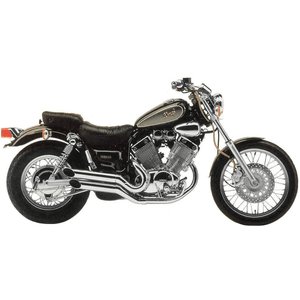Yamaha XV 535 Virago (1988–1996): A Timeless Cruiser for the Everyday Rider
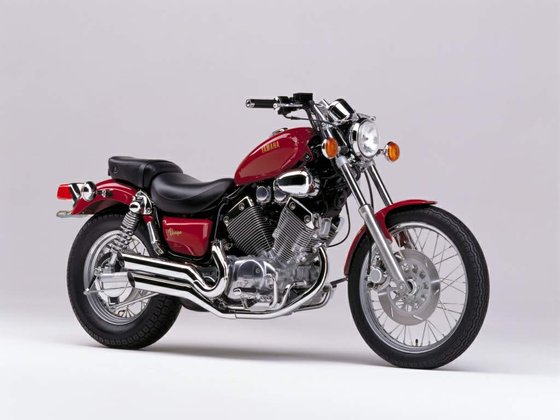
Introduction
The Yamaha XV 535 Virago isn’t just a motorcycle—it’s a cultural artifact. Introduced in 1988, this air-cooled V-twin cruiser became Yamaha’s answer to the American-dominated custom bike scene, offering reliability, approachability, and a dash of Japanese engineering finesse. For nearly a decade, the XV 535 carved out its niche as the “starter cruiser” that refused to quit, appealing to new riders, urban commuters, and anyone craving a fuss-free two-wheeled companion.
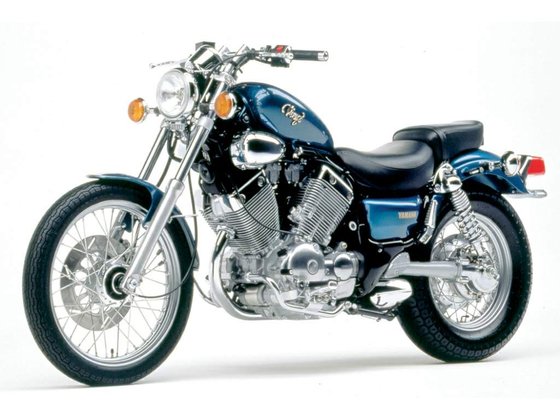
The XV 535’s low-slung profile and minimalist design made it an instant classic.
From its signature 70-degree V-twin engine to its shaft-driven simplicity, the Virago prioritized substance over spectacle. Let’s dissect why this motorcycle remains a cult favorite—and whether it still holds up as a practical ride today.
Design & Ergonomics: Form Follows Function
The XV 535’s design language is pure cruiser: a teardrop fuel tank, staggered dual exhausts, and a solo-style seat that sits just 720 mm (28.3 inches) off the ground. For riders intimidated by towering adventure bikes or sportbikes, the Virago’s accessibility is its superpower. Even at a standstill, it feels planted, with a dry weight of 182 kg (401 lbs) that’s manageable for its class.
The riding position strikes a balance between relaxed and practical. Unlike cruisers with floorboards stretched to the horizon, the Virago’s mid-mounted pegs and upright bars create a neutral posture. This makes it surprisingly agile in city traffic—no yoga stretches required. The bench seat, while plush for the rider, offers minimal real estate for passengers, reminding you this is a solo-focused machine.
Yamaha kept the dashboard refreshingly analog: a single speedometer, warning lights, and a reserve fuel switch on the handlebars. No tachometer? No problem. The Virago’s engine speaks in vibrations, not rev counters.
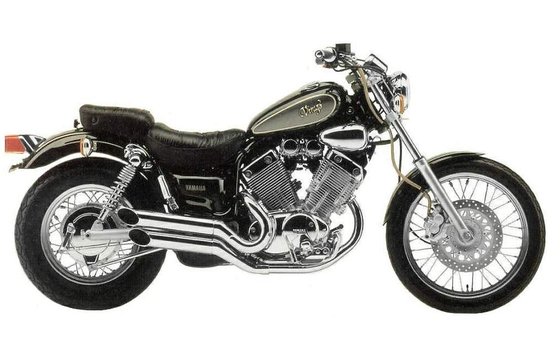
The minimalist dashboard emphasizes the bike’s no-nonsense ethos.
Engine & Performance: Smooth Operator
At the heart of the XV 535 lies its 535 cc air-cooled V-twin, a workhorse that churns out 44–46 HP (32–34 kW) and 43–48 Nm (31–35 lb-ft) of torque. These numbers won’t set drag strips ablaze, but they’re perfectly tuned for the bike’s mission: effortless low-end grunt and buttery-smooth delivery.
Twist the throttle, and the engine responds with a muted burble, pulling strongly from 2,000 RPM onward. The power peaks at 7,500 RPM, but you’ll rarely need to venture beyond 5,000 RPM in daily riding. Cruising at 100–110 km/h (62–68 mph) feels relaxed, though the engine starts vibing like a jackhammer near its 159 km/h (99 mph) top speed.
The 5-speed transmission pairs with Yamaha’s trademark shaft drive, eliminating chain maintenance headaches. Shifts are deliberate, with a slight clunk between first and second—a quirk that becomes endearing over time.
Key Specs:
- Bore x Stroke: 76 x 59 mm (3.0 x 2.3 inches)
- Compression Ratio: 9.0:1
- Fuel Capacity: 13.5 L (3.5 gal)
- Fuel Economy: ~17.6 km/L (41 mpg)
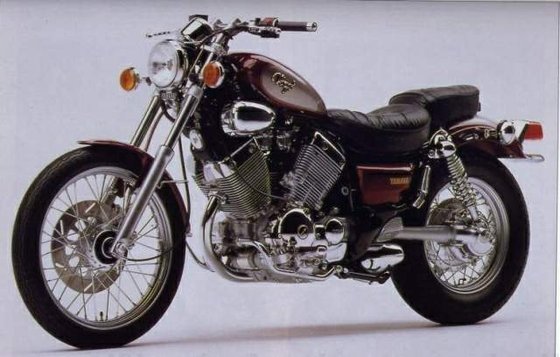
The 535 cc V-twin’s staggered exhausts are a hallmark of the Virago’s design.
Ride Experience: Urban Zen, Highway Compromises
City Riding:
The Virago shines in stop-and-go traffic. Its low seat, narrow profile, and 1511 mm (59.4 in) wheelbase make filtering through gridlock a breeze. The cable-operated clutch is light, and the throttle response is forgiving—no herky-jerky surprises here.
Highway Manners:
At higher speeds, the Virago’s limitations surface. The suspension (telescopic forks up front, twin shocks at the rear) leans toward comfort over precision, wallowing slightly during aggressive cornering. Wind protection is nonexistent, and the single 298 mm front disc brake demands a firm squeeze for rapid stops.
Handling Quirks:
- Ground Clearance: 145 mm (5.7 in) means scraping pegs on tight corners.
- Front-End Feel: The 36 mm forks lack adjustability but absorb potholes adequately.
- Shaft Drive Effect: Mild driveline lurch during abrupt throttle changes—a small price for zero chain maintenance.
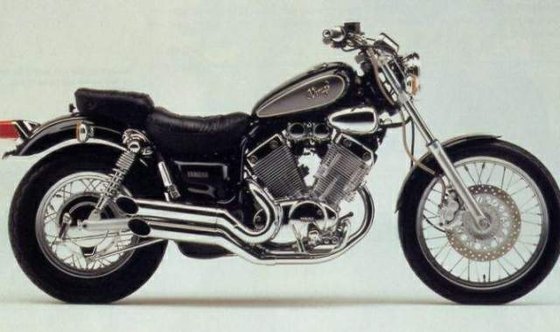
The Virago’s relaxed geometry encourages laid-back cruising, not knee-down heroics.
Competition: How the Virago Stacks Up
1. Honda Shadow VLX 600 (1988–1996)
- Pros: Slightly more power (52 HP), liquid cooling.
- Cons: Chain drive, heavier at 206 kg (454 lbs).
- Verdict: The Shadow feels more “modern” but loses the Virago’s mechanical simplicity.
2. Suzuki Intruder VS700 (1987–1995)
- Pros: Bold styling, hydraulic valve lifters (no adjustments needed).
- Cons: Heavier (223 kg / 492 lbs), complex hydraulic clutch.
- Verdict: The Intruder’s a head-turner but less beginner-friendly.
3. Harley-Davidson Sportster 883 (1986–1996)
- Pros: Iconic branding, aftermarket support.
- Cons: Vibration-heavy, air-cooled Evolution engine runs hot.
- Verdict: The Sportster’s a lifestyle choice; the Virago’s a daily rider.
Why the Virago Wins: Lighter weight, shaft drive, and lower seat height make it the most pragmatic pick for new riders.
Maintenance: Keeping the V-Twin Alive
The XV 535’s mechanical simplicity is a DIYer’s dream. Here’s what owners need to know:
1. Valve Adjustments
- Intake: 0.07–0.12 mm (0.0028–0.0047 in)
- Exhaust: 0.12–0.17 mm (0.0047–0.0067 in)
Check every 4,000 km (2,485 mi)—a straightforward job with basic feeler gauges.
2. Oil & Fluids
- Engine Oil: 2.8 L (0.74 gal) of SAE 10W-40 (API SE grade).
- Fork Oil: 228 mL (7.7 oz) of SAE 10W per leg.
- Final Drive Oil: 190 mL (6.4 oz) of SAE 80W GL-4.
3. Carburetor Tuning
The twin Mikuni BDS34 carbs crave cleanliness. Set idle mixture screws to 2–2.5 turns out and sync annually.
4. Tire Pressures
- Front: 2.0–2.1 bar (29–30 psi)
- Rear: 2.2–2.5 bar (32–36 psi)
5. Brake Care
Upgrade to sintered pads for improved bite, and flush DOT 4 fluid every two years.
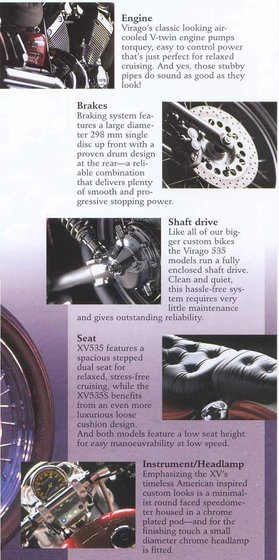
The shaft drive eliminates chain maintenance—a boon for casual riders.
Conclusion: The Everyman’s Cruiser
The Yamaha XV 535 Virago isn’t about breaking boundaries—it’s about delivering a hassle-free riding experience. Its air-cooled engine, shaft drive, and approachable ergonomics make it a timeless choice for commuters and cruiser-curious riders alike. While modern bikes offer more tech and power, few match the Virago’s blend of simplicity and charm.
For owners looking to personalize their XV 535, MOTOPARTS.store offers a range of upgrades:
- Comfort: Gel seats, taller windscreens.
- Performance: Free-flow air filters, aftermarket exhausts.
- Aesthetics: Custom handlebars, chrome accents.
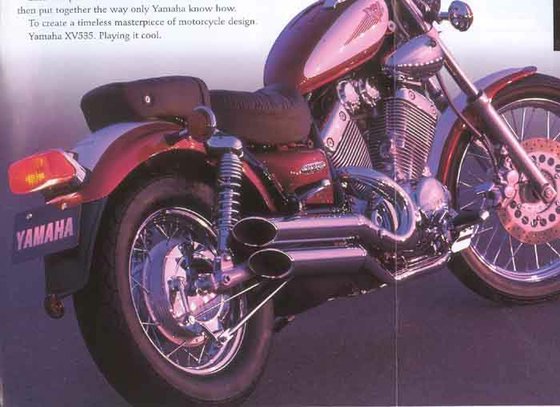
With basic care, the Virago promises decades of reliable service.
In a world obsessed with specs and speed, the XV 535 reminds us that sometimes, slow and steady really does win the race.

Specifications sheet
| Engine | |
|---|---|
| Stroke: | Four-stroke |
| Max power: | 44 kW | 59.0 hp |
| Max torque: | 43 Nm |
| Fuel system: | 2x Mikuni BDS34 carburetors |
| Max power @: | 7500 rpm |
| Displacement: | 535 ccm |
| Max torque @: | 6000 rpm |
| Configuration: | V |
| Cooling system: | Air-cooled |
| Compression ratio: | 9.0:1 |
| Number of cylinders: | 2 |
| Valves per cylinder: | 2 |
| Dimensions | |
|---|---|
| Wheelbase: | 1511 mm (59.4 in) |
| Dry weight: | 182 |
| Wet weight: | 196 |
| Seat height: | 720 mm (28.3 in) |
| Ground clearance: | 145 mm (5.7 in) |
| Fuel tank capacity: | 13.5 L (3.5 US gal) |
| Drivetrain | |
|---|---|
| Clutch: | Wet multi-plate, cable-operated |
| Final drive: | shaft |
| Transmission: | 5-speed constant mesh |
| Maintainance | |
|---|---|
| Engine oil: | 10W40 |
| Idle speed: | 1200 ± 50 RPM |
| Brake fluid: | DOT 4 |
| Spark plugs: | NGK BPR7ES or NGK BPR7EIX |
| Spark plug gap: | 0.8 |
| Forks oil capacity: | 0.456 |
| Engine oil capacity: | 2.8 |
| Final drive oil capacity: | 190 ml SAE 80W GL-4 |
| Engine oil change interval: | Every 5000 km or 2 years |
| Valve clearance (intake, cold): | 0.07–0.12 mm |
| Valve clearance check interval: | 24,000 km / 15,000 mi |
| Valve clearance (exhaust, cold): | 0.12–0.17 mm |
| Recommended tire pressure (rear): | 2.5 bar (36 psi) |
| Recommended tire pressure (front): | 2.25 bar (33 psi) |



